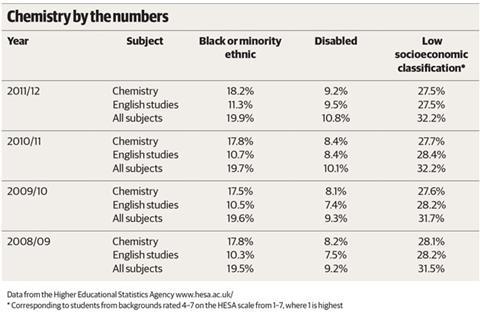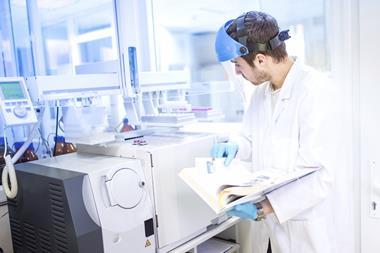How does chemistry fare when it comes to widening participation to groups who have traditionally not studied the subject? Anthony King looks at the numbers

In the past, the foremost chemists of the age were white males. Yet it is debatable whether chemistry in the 21st century has succeeded in attracting real diversity to its ranks.
The gender imbalance in chemistry became so obvious in recent years that learned societies and others weighed in to try address the issue (see feature Stemming the tide). But less is understood about overall diversity in chemistry. Is the bar to participation higher for certain ethnic or socioeconomic groups, disabled people or those who belong to particular religions or the LGBT (lesbian, gay, bisexual and transgender) community?
Chemistry benefits when its proponents approach problems from a variety of angles and narrowing the base, some argue, impedes the community’s potential for innovation. Also, cutting out sections of society from chemistry squeezes off a critical supply of new thinkers for the chemistry research enterprise.
‘If you are not taking a representative sample of the population you are almost certainly missing out on talent. So attracting a more diverse population to study and work in chemistry and science in general ought to increase the quality of the chemistry pool,’ argues Sean McWhinnie, a consultant on diversity issues who has done studies for academic societies. ‘There is also a view that a more diverse workforce gives greater creativity and that if your research and development workforce reflects your customers you are more likely to get products your customers want.’ The need to embrace diversity is also now enshrined in UK law.
Ethnic minorities
In the UK, the composition of chemistry varies by ethnic group, but the issue is complicated. ‘If you ask whether chemistry reflects society in terms of ethnic mix, the answer is it depends on the ethnic group,’ says McWhinnie. Generally, he says, chemistry is not bad in reflecting the ethnic diversity of the UK population, though black Caribbean men and Bangladeshi females are egregiously underrepresented among chemistry students. Asian groups and black Africans are reasonably represented.

British Indian and Chinese people are more likely to go to university than whites, and British Indians in particular are more likely than the general population to take chemistry at A-level. This is perhaps because of a culture in the Asian community of opting for courses with a vocational path for which chemistry is a prerequisite. Data show that Asian students are more likely than other groups to opt for medicine, pharmacy or ophthalmogy courses at university. Almost 30% of ophthalmics graduates are of British Indian origin, whereas they make up 2.5% of the population.
Black and minority ethnic students are less likely to get a good degree than their white peers
Gary Loke
Whether chemistry should strive to ‘poach’ such students to its own field is open to dispute. ‘British Indians and Chinese are more likely to do A-levels in science, so there is huge potential if you can attract them into engineering, physics and chemistry, but its an interesting strategic question whether you should,’ says McWhinnie. ‘My gut feeling is in the long term it may be more effective to put more effort into encouraging underrepresented groups, such as those from lower socioeconomic groups, to go to college in the first place.’
There is a problem regarding diversity in science, confirms Gary Loke, head of policy at the Equality Challenge Unit (ECU), a charity supporting equality and diversity in UK higher education. ‘We know there is a differential attainment gap, and BME (black and minority ethnic) students are less likely to get a good degree than their white peers.’ The ECU works with higher educational institutions to address issues impeding equality and participation of certain groups. For example, colleges might ask for advice and support to help fasting students, knowing that Ramadan clashes with the exam timetable in the next couple of years.
The Higher Educational Statistics Agency (HESA) collects data and allows institutes to interrogate them, filtering by disability, ethnicity, gender and age. HESA’s figures for UK-domiciled first degree students at UK higher education institutions in 2011/12 show the BME group at 19.9% for all subjects, 11.3% for English studies and 18.2% for chemistry. For socioeconomic class, the figures show that students from poorer backgrounds are underrepresented in chemistry (at 27.5%) compared to the main student body (where they make up 32.2%).
Social background
Socioeconomic class is believed to work against poorer sections of society participating in science and chemistry, but it is difficult to get a handle on. As Loke points out, socioeconomic measures require proxy indicators and some are better than others. Postcodes or free school meals are used as indicators, but neither is really robust. The most usual indicator for undergraduate entry asks a 17-year-old to self-report their parents’ occupations and the description here – for example, farmer or farm manager – places them into different socioeconomic categories. ‘Unlike gender, it is harder to measure. It is fluid and self-reported,’ says Loke.

When organic chemist Paul Taylor at the University of Warwick in the UK looked at socioeconomic factors and potential physical science students a number of years ago, it proved difficult to draw conclusions because ethnicity was such a significant confounding factor. However, it did seem that how students are guided – or not guided – towards science subjects was important. In this regard, he found that Asian students tended to have a clearer career path ahead of them. Regardless of how wealthy they were, the family encouraged them to go into something vocational like pharmacy.
‘One other thing we noted was the disastrously poor career advice given in comprehensive schools compared with fee-paying schools,’ Taylor explains. ‘This is oversimplifying, but poorer kids going to a rough school, however clever, were getting lamentably poor career advice with respect to science. The kids didn’t have the faintest clue about studying chemistry or what it might lead to. If they did, they got it from their families.’
Poorer kids going to a rough school were getting lamentably poor career advice
Paul Taylor
His focus is now on the experience of people who come into the higher education system from different backgrounds and how it can be improved for them. Practical measures can bolster integration and performance of otherwise potentially marginalised students, and these measures often benefit everyone. Taylor carried out a small focus group study of students from the ‘usual’ backgrounds coming into university and those from non-traditional backgrounds, such as those from lower socioeconomic groups, as defined by access to university scholarships. ‘One of the biggest issues they faced was the feeling they didn’t fit in,’ says Taylor. ‘They tended to feel everyone was better than them. We identified a lack of confidence and a need for feedback.’ The solution was to test earlier in the first year, so that all students got feedback on how they were progressing earlier – a benefit to all.
Taylor also notes that students that may have come from a ‘rough’ city school were usually highly motivated. ‘That is how they got there,’ he says. ‘Their motivation is stronger and more vocational and they wanted to achieve something. Some had more altruistic goals, so their drivers may be somewhat different. That changed their focus on the kinds of activities they wanted to be involved in. They didn’t want to study just to get marks.’ Understanding such differences should improve how such students can be catered for.
Staff diversity
McWhinnie notes that the proportion of women has been rising among staff, but ethnic diversity among staff who are UK nationals is still very low in chemistry departments, though there is diversity in terms of different nationalities. ‘There are people of non-white origin in UK universities,’ he says, ‘but the fact I can start naming them tells you something.’ Taylor agrees that there are not many non-white chemistry professors in UK universities and ethnic diversity is lacking at the higher echelons. This needs investigating, and he says the Royal Society of Chemistry – he is a member of its diversity working group – needs to take the same approach as it already taking to gender.
We could end up with cities where there is nowhere for people to read chemistry
Sean McWhinnie
Loke says that there is anecdotal evidence that BME staff members are more likely to leave the UK to pursue a career abroad. ‘We don’t know the reason for that, so we will be commissioning a project later this year to look at the experience of BME academics and why they move abroad,’ he says.
The closure of chemistry departments in different areas could negatively influence take-up and impede certain groups. Ethnicity and socioeconomic status are known to have a bearing on how far students are willing to travel, with wealthier cohorts willing to go further. McWhinnie says choices for chemistry students in London and other areas are receding and we could end up with cities where there is nowhere for people to read chemistry. This could affect some groups more than others – for example, Muslim girls are less likely to be allowed away from home to study.
Societies’ efforts
McWhinnie was previously involved in a study looking at what made different ethnic minorities choose different subjects. ‘We suspected parental and family influence was very strong, but the young people tended to deny that as a factor. But you would, wouldn’t you?’ he says. The influence of parents and the need for role models is something the American Chemical Society is well aware of in its work to attract minorities and underrepresented groups into chemistry. The ACS notes that US workforce chemists are more likely than the overall population to be white (82% vs 63%) or Asian (9.9% vs 5.1%). Other racial minorities are underrepresented in chemistry, although Hispanic chemists are becoming more common.
The reward for diversity is that it brings about greater innovation
Glenn Ruskin
The society has an ambassador programme, equipping its members with what it takes to be a chemistry advocate. Jason Ge, a US winner in the international chemistry Olympiad, got together with other college students to run a chemistry magic show with the help of the ACS to inspire students in low-income schools in California with a set of fun experiments involving the kids hands on. ‘There is a big difference between me as a 50-year-old man going into a school auditorium and them doing it; there’s a big disconnect [with me], but not with them,’ says Glenn Ruskin, director of the ACS public affairs office.
The ACS’s SEED project offers bright, economically disadvantaged high school students the chance to perform research under the supervision of a volunteer scientist mentor at a university. Ruskin says reaching out to young people from tough backgrounds with programmes like SEED is something members are enormously proud of. ‘We have pulled them into a professional situation that they never would have had before. You reach out to a young person who had no idea that they had the capability or interest to do this and you increase the diversity of the scientific enterprise,’ says Ruskin.
He says adding different ethnic, cultural and economic backgrounds can change the dynamic around a lab when it comes to problem solving. ‘I’ve had first-hand experience of this. The outcome is far better when everyone participates,’ Ruskin explains. ‘The reward for diversity is that it brings about greater innovation.’
The ACS has been outstanding in its multi-faceted approach, comments Carlos Gutiérrez, an organic chemist at California State University, Los Angeles (see profile Different strokes). Chemistry ‘has done a lot but overall gets a “C” for effort, because the problem is so big. Percentage increases are huge, but misleading. The base is so small that doubling or tripling still results in very small absolute numbers of minority group members entering the scientific workforce.’ He points to huge groups of American youth from populations that have historically not participated in careers in the broad molecular sciences. It’s a critical issue, he says: ‘If we do not develop the talents of all American populations, including “minorities”, who will be available to do the scientific work of the nation?’

The RSC is striving to embed diversity and is working on an overall diversity strategy, following up on the recommendations in the diversity audit. The society launched ‘175 faces of chemistry’ in October 2012 to celebrate diversity in the chemical sciences and raise the profile and awareness of diversity issues. The Royal Society has a four-year government-funded programme looking for ways to remove barriers to entry, retention and progression within the scientific workforce. It will focus on gender, ethnicity, disability and socioeconomic status and conduct research and pilots.
Taylor sees a major problem with diversity studies in the UK – a lack of data. ‘If you are going to do sociological work, you ideally start with quantitative data. But that is what we are missing. Does anybody know what the ethnic diversity of the professional chemistry community is in the UK? I believe the answer is no,’ he says. ‘The question now is should we start collecting data and what data should we collect? Should people be asked about their religion or sexual orientation?’ He views the RSC’s work on gender as being successful partly because the issue was clearly identifiable in data. One reason the RSC focused on gender was it was easy to see the problem. ‘You need real data and real conclusions’ if you want to convince scientists, he adds.
Taylor points to an RSC report1 that suggested that chemistry, being a well-established, ‘old’ discipline has developed a deep-seated culture and set of values. This is in contrast to some of the newer sciences such as biochemistry. The old culture maintains the rigour and professionalism of chemists, ‘but that same rigour and tradition can impede change’, says Taylor.
Future issues
Taylor says he has never heard anyone in chemistry even talk about sexual orientation – it is largely off the agenda. There has been no reason to collect data so far and perhaps people don’t want to disclose this information, but this doesn’t mean it shouldn’t be tried. ‘We are a long way from even being able to discuss it,’ Taylor says. ‘I don’t know if it is an issue, but it probably is. I can’t imagine chemistry as a discipline being most friendly to the LGBT community.’
There is a danger, he warns, of chemists confusing tradition with retention of power structures. And previous reports lifted the lid on some unpleasant practices in academia. ‘Read some of the gender studies that Jessica Lober-Newsome [ref 2] carried out and her portrayal of tyrannical chemistry professors terrorising students. That was from a female perspective, but would it be so much better if you were black or gay? Your fear is that it would have been just as bad, but it’s just that we haven’t done the studies yet,’ Taylor concludes.
Anthony King is a science writer based in Dublin, Ireland
References
1The molecular bioscience PhD and women’s retention, RSC, 2008. http://rsc.li/14OibvC
2The chemistry PhD: the impact on women’s retention, RSC, 2008. http://rsc.li/14DgUra












No comments yet